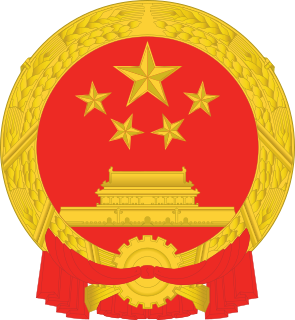
The State Council, constitutionally synonymous with the Central People's Government since 1954, is the chief administrative authority of the People's Republic of China. It is chaired by the premier and includes the heads of each of the cabinet-level executive departments. Currently, the council has 35 members: the premier, one executive vice premier, three other vice premiers, five state councilors, and 25 additional ministers and chairs of major agencies. In the politics of the People's Republic of China, the Central People's Government forms one of three interlocking branches of power, the others being the Communist Party of China and the People's Liberation Army. The State Council directly oversees the various subordinate People's Governments in the provinces, and in practice maintains membership with the top levels of the Communist Party of China.

Hakka, also rendered Kejia, is one of the major groups of varieties of Chinese, spoken natively by the Hakka people throughout southern China, Taiwan, Hong Kong, Macau and throughout the diaspora areas of East Asia, Southeast Asia, and in overseas Chinese communities around the world.
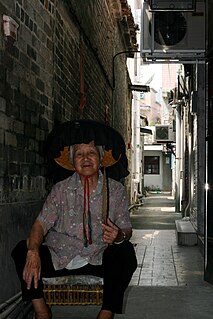
The Hakka, sometimes Hakka Han, are Han Chinese people whose ancestral homes are chiefly in the Hakka-speaking provincial areas of Guangdong, Fujian, Jiangxi, Guangxi, Sichuan, Hunan, Zhejiang, Hainan and Guizhou. The Chinese characters for Hakka (客家) literally mean "guest families". Unlike other Han Chinese groups, the Hakkas are not named after a geographical region, e.g. a province, county or city, in China. Modern day Hakka are generally identified by different degrees of Hakka ancestry and usually speak the Hakka language.
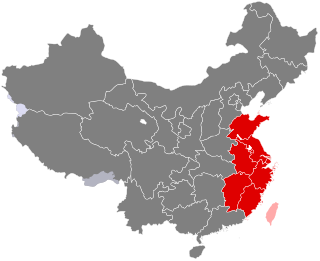
East China or Eastern China is a geographical and a loosely defined cultural region that covers the eastern coastal area of China.

Zhangjiakou also known by several other names, is a prefecture-level city in northwestern Hebei province in Northern China, bordering Beijing to the southeast, Inner Mongolia to the north and west, and Shanxi to the southwest. At the 2010 census, its population was 4,345,485 inhabitants on 36,861.56 square kilometres (14,232.33 sq mi), divided into 17 Counties and Districts. The built-up area made of Qiaoxi, Qiaodong Districts and Wanquan County largely being conurbated had 838,978 inhabitants in 2010 on 1,412.7 km2 (545.4 sq mi). Due to its position on several important transport arteries, it is a critical transport node for travel between Hebei and Inner Mongolia and connecting northwest China, Mongolia, and Beijing.
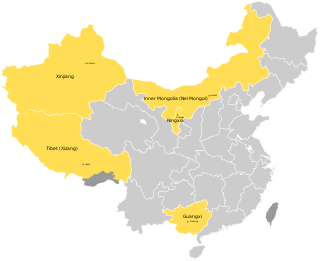
An autonomous region is a first-level administrative division of China. Like Chinese provinces, an autonomous region has its own local government, but an autonomous region has more legislative rights. An autonomous region is the highest level of minority autonomous entity in China, which has a comparably higher population of a particular minority ethnic group.

Xiangxi Tujia and Miao Autonomous Prefecture is an autonomous prefecture of the People's Republic of China. It is located in western Hunan province. It consists of 1 city, Jishou, and 7 counties: Baojing, Fenghuang, Guzhang, Huayuan, Longshan, Luxi, Yongshun. The capital is Jishou. Twenty-five nationalities gather here, of the total 2,480,000 population, 66.6 per cent are ethnic minorities, including 860,000 Tujia and 790,000 Miao.

Zhangjiagang, formerly Shazhou County, is a county-level city under the administration of Suzhou, Jiangsu province, China and one of the many ports along the Yangtze river.

Southwest China is a region of the People's Republic of China defined by governmental bureaus that includes the municipality of Chongqing, the provinces of Sichuan, Yunnan and Guizhou, and the Tibet Autonomous Region.
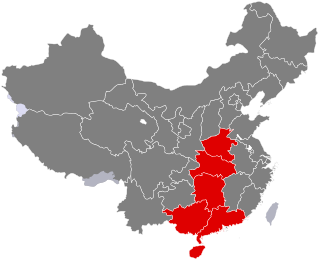
South central China is a region of the People's Republic of China defined by governmental bureaus that includes the provinces of Guangdong, Hainan, Henan, Hubei, and Hunan, and the Guangxi Zhuang Autonomous Region, however the two provincial-level special administrative regions (SAR) are also often included under south central China: Hong Kong and Macau. This part is often divided into south China (华南) and central China (华中) regions due to difference between civilian customs.

The Battle of Wanjialing, known in Chinese text as the Victory of Wanjialing, refers to the Chinese Army's successful engagement during the Wuhan theatre of the Second Sino-Japanese War against the Japanese 101st, 106th, 9th and 27th divisions around the Wanjialing region in 1938. The two and a half month battle resulted in heavy losses of the Japanese 101st and 106th Divisions.

Gaomi is a county-level city of eastern Shandong province, China, under the administration of Weifang City. It is the hometown of writer and 2012 Nobel Prize in Literature winner Mo Yan, who has set some of his stories in the region.
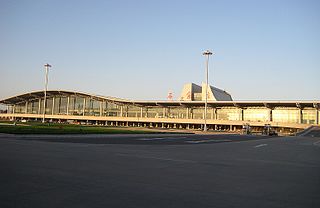
Shijiazhuang Zhengding International Airport is the primary airport serving Shijiazhuang, the capital of Hebei province, China. The airport is the hub for Hebei Airlines and a focus city for both China United Airlines and Spring Airlines. It is also the sole airport in China that Antonov An-225 can operate.

Qingchuan County is a county in the northeast of Sichuan province, China, bordering the provinces of Gansu to the north and Shaanxi to the northeast. It is the westernmost county-level division of the prefecture-level city of Guangyuan. It has an area of 3269 square kilometers and a population of 248,000, including Han Chinese as well as Hui people.

Xinbei District, alternatively called the New District or the High-tech Development Zone, is one of five district under the jurisdiction of Changzhou in Jiangsu province of the People's Republic of China. The local language is the Changzhou dialect of Wu Chinese. It covers an area of 425 km2 (164 sq mi) in the northern part of Changzhou's administrative area. In 2005 the total population was recorded at 480,000 people. The postal code for the district is 213161.

State Administration of Foreign Experts Affairs is an administrative agency of the State Council of the People's Republic of China responsible for certifying foreign experts to provide expertise in mainland China. Foreign experts can include people from all around the world, including Hong Kong, Macau and Taiwan region in the fields of economy, technology, management, education, engineering, science, culture, healthcare. The foreign experts usually work in foreign invested joint-ventures, private industry, state-owned enterprises and key public construction projects.
Events in the year 1938 in China.

South China or southern China is a geographical and cultural region that covers the southernmost part of China. Its precise meaning varies with context.

Ronggui Sub-district is a sub-district in Shunde, Foshan, Guangdong, China, which is at the southeast of Shunde and a part of Shunde City Zone. It was formed by the merging of Rongqi Town (容奇镇) and Guizhou Town (桂州镇). It has a resident population of 460,000 with its total area of 80 square kilometers.



















